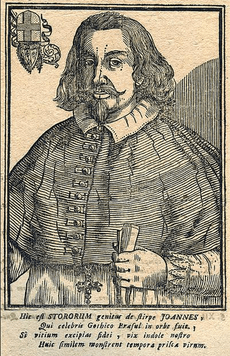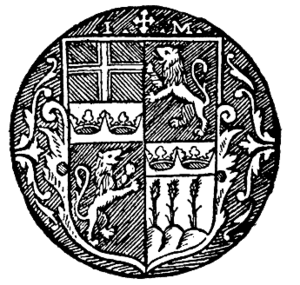Johannes Magnus facts for kids
Quick facts for kids The Most Reverend Johannes Magnus |
|
|---|---|
| Archbishop of Uppsala Primate of Sweden |
|

Johannes Magnus
|
|
| Church | Catholic Church |
| Diocese | Uppsala |
| Enthroned | 1524 |
| Reign ended | 1531 |
| Predecessor | Gustav Trolle |
| Successor | Olaus Magnus |
| Personal details | |
| Birth name | Johan Månsson |
| Born | 19 March 1488 Linköping, Sweden |
| Died | 22 March 1544 (aged 56) Rome, Papal States |
| Nationality | Swedish |
| Denomination | Roman Catholic |
| Parents | Father: Måns Pedersson Mother: Kristina Kruse |
| Occupation | Historian, Genealogist |
Johannes Magnus (born Johan Månsson, later changed to a Latin form) was an important Swedish leader. He was the last Catholic Archbishop in Sweden. He was also a theologian (someone who studies religion), a genealogist (someone who studies family histories), and a historian (someone who studies history). He was born on March 19, 1488, and passed away on March 22, 1544.
Contents
Life of Johannes Magnus
Johannes Magnus was born in Linköping, Sweden. His father was Måns Pedersson, a burgess (a citizen of a town). His mother was Kristina Kruse.
Becoming Archbishop in Sweden
In 1523, King Gustav I Vasa chose Johannes Magnus to become the new Archbishop. An Archbishop is a very important religious leader. Johannes was planning to travel to Rome to be officially appointed by the Pope.
However, a message arrived from Pope Clement VII. The Pope said that the previous Archbishop, Gustav Trolle, should be put back in his position. Gustav Trolle was living in another country at the time. The Pope's message said that removing Trolle was against the rules.
But King Gustav Vasa saw Gustav Trolle as a traitor to Sweden. So, the King could not let Trolle be Archbishop again. King Gustav ignored the Pope's message. He went ahead and made Johannes Magnus Archbishop without the Pope's full approval.
Challenges and Exile
Soon, Johannes Magnus disagreed with the King. He did not like the new Lutheran teachings that were spreading in Sweden. These teachings were supported by King Gustav Vasa and led by the brothers Olaus and Laurentius Petri.
Because of his disagreement, the King sent Johannes Magnus away in 1526. He was sent to Russia as a diplomat. Johannes knew that the King did not want him back in Sweden. So, he was careful not to return home.
In 1531, King Gustav Vasa chose a new Archbishop, Laurentius Petri. Johannes Magnus then understood that his time as Archbishop in Sweden was over.
Life in Italy
Meanwhile, Johannes's brother, Olaus Magnus, had gone to Rome. He wanted to explain the situation with Gustav Trolle to the Pope. In 1533, the Pope finished looking into the matter. He decided that Johannes Magnus was the right person to be the Archbishop.
Johannes then traveled to Rome to be officially appointed. But by this time, Sweden was no longer following the Pope's directions. Because of this, both Johannes and Olaus stayed in Italy for the rest of their lives.
Johannes Magnus spent his time in Venice and Rome. There, he wrote two important history books about Sweden. These books are called Historia de omnibus Gothorum Sueonumque regibus and Historia metropolitanæ ecclesiæ Upsaliensis. They contain valuable historical information. However, they also include many stories that are not based on real facts.
Johannes Magnus passed away in Rome in 1544. After his death, the line of Swedish Archbishops appointed by the Pope came to an end.
Johannes Magnus's Writings
One of Johannes Magnus's most famous books is Historia de omnibus Gothorum Sueonumque regibus. This title means "History of all Kings of Goths and Swedes." It is a book about Swedish history.
Johannes's brother, Olaus Magnus, had the book printed in Rome in 1554, after Johannes died. Olaus sent copies to Sweden. He dedicated the book to King Gustav's sons: Eric, John, Magnus, and Charles. The book was printed again many times. The first Swedish translation came out in 1620.
Creative History and Patriotism
For early Swedish history, this book is not always accurate. Johannes Magnus used older writings, like Getica by Jordanes and works by Saxo Grammaticus. He used them to create a history of the Swedish people and their kings.
He even claimed that Magog, a son of Japheth from the Bible, was Sweden's first king. The first 16 parts of the book cover the time before the year 1000. It mixes old tales with his own made-up stories. He said these stories came from ancient runic writings in Uppsala.
Johannes Magnus also invented a list of Swedish kings. He added six kings named Eric before Eric the Victorious. He started counting from a king named Berig as Eric I. He also created six kings named Charles before Charles Sverkersson. This is why King Gustav I Vasa's sons could call themselves Eric (XIV) and Charles (IX).
His book describes these made-up Erics and Charles as good rulers. But it also includes a few invented bad rulers with names similar to Gustav.
The book is very patriotic. It even suggests that Denmark was settled by criminals sent away from Sweden. This claim made the Danish court very upset.
Johannes Magnus's work was important for a movement called Gothicism in Sweden and Europe. This idea suggested that humankind came from the North. It gave the northern lands strong political and spiritual meaning.
See also
 In Spanish: Johannes Magnus para niños
In Spanish: Johannes Magnus para niños



